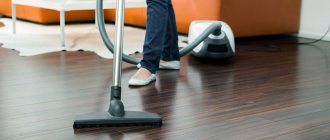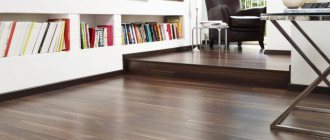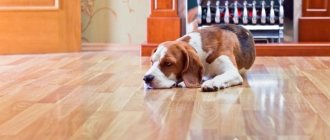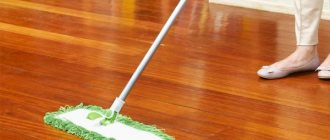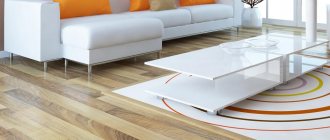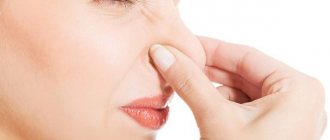Laminate has long become an affordable and practical alternative to expensive parquet. The flooring has high performance characteristics, so the material is used in residential areas. Chemical components are added to the raw materials, which theoretically can affect human health. In this article we will analyze in detail the facts about the safety and dangers of finishing.
What does the board consist of Source park-laminata.ru
Real and far-fetched advantages of the material
Manufacturers of the product talk exclusively about its advantages. The characteristics sound attractive, but not all of them are true:
- They say that this is a very durable material - resistant to mechanical abrasion and increased loads. But in practice, such properties are inherent only in some of the most expensive coatings;
- A variety of decorative finishes allows you to choose the laminate suitable for the room. With the help of many textured patterns and shades of board color, the designer will be able to visually enlarge the room and, if necessary, hide minor defects and unevenness of the floor. Different colors and patterns of the laminate will allow you to create separate zones in the room or geometric patterns on the floor surface. This statement is true, the new coating actually looks presentable and aesthetically pleasing;
- The simplicity of laying the coating is attractive; almost every home owner can do it independently. The boards are joined together into a deck using special locks on the edges. They may differ in design (the more expensive the material, the more complex the design, more reliable and at the same time easier to connect the locks). Laminate is never attached to the floor; it is placed on the surface in the form of a “floating” coating. For this reason, if necessary, even one damaged board can be easily replaced. But only high-quality models have these properties, which have securely connecting locks with the correct shapes. It is necessary to take into account that even very expensive material will not be able to be laid quickly and well without preparing the base. On an uneven base, and an expensive substrate will not be able to save it, the coating will begin to sag, it will not be possible to lay it evenly, and after a while a squeak will begin to be heard or deformation may occur. The locks of inexpensive laminate models do not have an exact fit; they often become jammed during installation, and the boards do not connect well;
- This material does not require special processing or special care. It does not need to be sanded, it is not impregnated with wax or oil like parquet, which is familiar to everyone. You just need to vacuum the floor occasionally and wipe it with a damp cloth. This is true, since the artificial surface layer on the laminate does not need additional protection;
- Laminate boards can withstand minor mechanical impacts without damage. Any accompanying manual states that the laminate is not afraid of sharp heels of shoes. It will not be harmed by massive furniture even when moving around the room; the material will not be damaged by a fallen match or a burning cigarette. But this must be trusted with caution. A separate expensive laminate is well protected from such influences, but there is still a resistance threshold. For example, marks from heels will not appear on the surface, but strong heat or fire, or furniture legs when moving, will leave marks on the surface;
- It successfully resists abrasion; indeed, expensive material has this property. But cheap material will not remain in its original condition for long. Abrasion will quickly begin to show in areas where people frequently walk. For example, the wheels of a chair will completely erase both the protective and decorative layer in a short period of time. Expensive laminate will look good longer, but over time it will become unusable;
- Laminate is cheaper than other flooring materials. But if you look at the cost of quality products, it becomes clear that high-quality linoleum can be cheaper;
- Additionally, it insulates the floor; laminate itself is not insulation. Protection from the cold occurs thanks to the underlay, which is required when laying boards, or a “warm floor” installed under the covering. Flooring alone cannot insulate a concrete floor;
- Some manufacturers claim that their laminate protects against noise, muffles sounds from falling things, and reduces sounds from clicking heels. This can only be observed in products made from natural cork. With a simple laminate, even a porous insulating substrate will not provide high-quality sound insulation.
§ 1. WHAT DOES LAMINATE CONSISTE OF? ARE ITS COMPONENTS HARMFUL?
Laminate is a board made of 4 layers, each of which performs its own function.
What does laminate consist of, layers in section
- The bottom layer is the base. Performs a protective and sound-proofing function and imparts rigidity to the laminate. It consists of the remains of woodworking production - sawdust, chips, shavings. As you can see, this layer is absolutely harmless and environmentally friendly.
- Bearing layer. Here are the “locks” with which the laminate is secured. Performs sound and noise protection functions. This layer is also not harmful to health.
- Decorative layer. The name itself speaks about its function. It is a layer of paper onto which an image is applied. We also do not see any harm to health.
- The top layer is protective. Protects the floor from abrasion and stress. It consists of a solution of a special resin, which is not entirely harmless to health. This is the point we will talk about more seriously.
Real and far-fetched disadvantages of the material
After assessing the positive properties and the actual behavior of the laminate during operation, you need to mention the possible disadvantages of this coating and think about how dangerous the laminate is if used incorrectly:
- The presence of phenol-formaldehyde components in the composition of the material has a harmful effect on human health. This is especially noticeable when a room heating system is placed under the laminate. People often complain about the appearance of an unpleasant chemical odor that lingers in the room for a long time after laying new flooring. When choosing certain models, it is better to opt for products with emission classes E1 and E0.5. Some expensive products are produced without the use of formaldehyde binders. Only resins that are completely harmless to humans are added to it;
- Low resistance to moisture even of expensive products. When leaks or breaks in water supply and heating pipes occur. When moisture can penetrate into the cracks between individual boards, deformation and swelling of individual sections of the floor or boards cannot be avoided. But this drawback is present in any floor coverings that are produced on the basis of wood components. The same reaction of the material is observed when the base is moistened. For example, when laying flooring on the first floor, under the floor there is a damp basement without insulation, and the floor has not been waterproofed. In some cases, even excess water during wet cleaning can harm laminated board flooring;
- It makes a lot of noise that disturbs both apartment residents and neighbors. The sounds of shoe heels, objects falling on the floor, and even footsteps in slippers all create noise. Due to its properties, this material is an excellent sound resonator. People sometimes think that if they lay the underlay thicker, the noise will be much less. This is a misconception - a thick underlying layer will only cause deformation of the joints of individual boards when exposed to load. This can even lead to breakage of the locks, because the coating will be laid not on a hard, but on a soft base.
- Possible deformations due to sudden changes in temperature, in some cases even for no apparent reason. Of course, there is definitely a reason, and these troubles occur as a result of a violation of the material installation technology;
- This material cannot be considered a coating that will last long. The maximum service life is approximately 7-8, at best it will not last longer than 10 years;
- Cheap material suffers greatly from mechanical stress and scratches. It can be damaged even when moving felt-lined furniture;
- It is difficult to remove colored and grease stains from the surface of such a floor, for this reason it should not be installed in the hallway, in the kitchen, or even in the children's room;
- These boards are cold to the touch, which is very unpleasant in winter;
- This floor can be very slippery;
- A static charge can accumulate in the laminate, which will be inappropriate if there is a lot of computer equipment in a room with such a floor. For this reason, it is better to use a coating with antistatic properties for these rooms;
- You should not install massive furniture on a laminate floor. Large weight will interfere with the free expansion of the boards as the temperature in the room increases. This will also cause the appearance of large gaps at the junctions of the boards and the places where they adjoin the walls, and to possible deformation of the entire coating layer;
- It does not withstand open fire well. When the coating is heated too much, a lot of toxic smoke comes out of it, which can cause burns to the respiratory tract and even cause suffocation;
- To get truly high quality coverage. Before installation, the base must be perfectly leveled. For example, form a very even screed or prepare a self-leveling floor in advance. Additional leveling will increase costs and require more time to repair. But it is difficult to call this feature a disadvantage of this particular material. Almost any decorative flooring requires good preliminary preparation of the base for installation.
Interesting article on the topic: What is the difference between parquet boards and parquet
Using laminate as a decorative floor covering in the house, especially “budget” models, will cause you a lot of problems, or at least controversial issues. In truth, each of the modern floor coverings is not perfect; they have their own positive properties and disadvantages.
Composition and its effects on health
Before determining whether a laminate is harmful or whether it is neutral for health, you need to understand the components contained in its composition and analyze their toxicity.
- Laminated board is a multilayer material. The layers of different components are well pressed together. To determine the danger of a particular part of it, you need to determine what it is made of and analyze the level of toxicity of the materials used;
- Surface coating is necessary to protect against various mechanical damage. This is the “laminating” layer;
- The decorative layer is made of polymer components or paper with a pattern reminiscent of natural stone, wood and other beautiful natural materials;
- Durable chipboard (HDF) is used as a base. The high pressure used when pressing components significantly reduces the amount of natural or artificial resins used. The resulting board is often stronger than natural wood;
- The lower part of the plate is made of moisture-resistant paper. It is required to reduce the flow of moisture and dampness from a base made of chipboard, since this material absorbs moisture well. To reduce moisture holding capacity and moisture penetration from below, this layer is impregnated with resins;
- Sometimes manufacturers add an additional special film under the decorative layer, which serves as additional protection from moisture for both the main slab of material and the upper layers.
Laminated boards are made from:
- In production, chipboard is used as a base; small wood waste is used for its production - crushed shavings, wood chips and sawdust. No one can have any questions about these components regarding their environmental friendliness. Wood particles are glued together using artificial or natural resins; the environmental friendliness and quality of these components depends only on the integrity and conscience of the floorboard manufacturer. Often these resins are used in the production of furniture, interior doors, and other things often used in everyday life. Wood materials impregnated with various resins are a very durable layer; the overall strength of the material and its ability to withstand static mechanical loads depend on it;
- A thin layer of paper and a special coating are applied to the surface of the material. For this purpose, acrylic or melamine resins are mainly used. Often in the production of paints and varnishes the same acrylic components are used. Melamine, by its qualities, is a material that does not have viscosity; for this reason, resin is made from it by combining it with a formaldehyde component. It will not be a secret that formaldehyde is a toxic substance for humans. This layer determines the level of protection of the coating surface from damage, resistance to chemicals, resistance to moisture, and is responsible for the color of the board and color retention. In some cases, the surface is additionally coated with varnish to create a glossy effect.
Anton Makarov
Expert of our site. She has been selling and installing floor coverings for over 7 years. Can give really valuable advice.
Ask a Question
Some manufacturers of laminated boards use another additional layer in the structure, which serves to reduce the effect of echo in the room and absorb the resulting noise. Between the main slab and the decorative finish there may also be a layer of material protecting it from moisture.
Each manufacturer uses its own manufacturing technology and design of the laminated board. But at the same time, the general sequence of the production process remains the same. Namely, the production of high-tech wear-resistant flooring.
During production, the board undergoes many different tests and tests for resistance to various influences. The release of harmful substances is checked in order to obtain the safest laminate possible.
Coating features
Laminate visually resembles a board or parquet. The parts are joined together using key joint technology (“groove to groove”). After installation, a warm, even coating remains on the floor, which is pleasant to walk on.
The structure of the laminate consists of 90% sawdust. Recycled shavings or crushed wood chips are compressed under high pressure. Glue is used to bind the ingredients to the base. Natural or synthetic resin is used as a fixative. As a result, wood residues acquire:
- strength of natural material;
- additional density;
- improved elasticity.
At the bottom of the laminate there is a thin paper or plastic backing treated with paraffin. The film reliably protects the product from moisture. Boards do not swell or deform when in contact with water. In a multilayer structure, fungus does not grow.
At what temperature does laminate release harmful substances?
The main danger of laminated boards is the formaldehyde it contains. The vapor released from it during use is harmful to health. But they are released from high-quality material only at high air temperatures.
Only when the laminate is very hot does the melamine resin convert the toxic components into gaseous form. Even in tropical conditions, this flooring does not become toxic, and in our temperate climate, even more so, under normal conditions it will not cause harm. Responsible manufacturers are well aware of the toxicity of the components and raw materials used. For this reason, fresh laminate is never sold straight off the production line. The material is weathered for a long time and kept in warehouse conditions.
Thanks to this design, the main part of the laminated board (over 90%) is made from environmentally friendly and completely safe components for people. To be completely sure of the safety of the material purchased on the market, you need to understand its classification and know the labeling of each of these classes.
In the air, a minimum amount of formaldehyde begins to appear only after heating above 32 degrees. Under such conditions, laminate flooring is no more damaged than chipboard furniture. When using a heated floor, the coating heats up more and formaldehyde is released more actively.
Is there any harm from laminate?
One of the common myths about laminate flooring is the increased release of formaldehyde, which is part of the durable wood board - the basis of this floor covering.
Indeed, the release of this substance can be detected even in expensive European laminate floors.
This is due to the natural content of formaldehyde in wood and the use of resins and compounds that increase the strength of the lamella.
But the standards in force in the European Union and Russia clearly define acceptable standards. And these standards are necessarily taken into account by manufacturers. To protect yourself, read the information on the packaging before purchasing laminate flooring. In this article we will tell you how to understand the labeling and purchase a floor that is guaranteed to be safe for your health.
Possible harm to laminate
Today, laminate is considered the most popular building material, which is used as a finishing flooring in various rooms.
Thanks to a wide color palette, various sizes and different classifications, these products can be installed in almost any room of various sizes and purposes, but in recent years the question has often been raised about whether laminate flooring is harmful to health or not. It’s difficult to give an unambiguous answer to this, so it’s worth delving deeper into this topic and examining all the nuances in more detail.
Laminate and its features
The popularity and authority of laminated coating is not in doubt. It is difficult to find a house or apartment where they have not resorted to using this construction product, since laminate is convenient in everything.
It is easy to install, easy to maintain, and has an excellent presentable appearance.
Laminate is affordable and easy to use
It is also worth listing its other advantages:
- affordable pricing policy;
- No specialized tools are required to install the product in an apartment;
- a huge color palette allowing you to choose the appropriate option for your interior;
- good performance if installation and maintenance requirements are met;
- the area covered with laminated flooring does not require additional treatment of the coating with antiseptics and varnishes.
In the initial stages of the product’s appearance, the question of the environmental friendliness of laminate did not even arise, since it was constantly compared to parquet, but it is not parquet.
Many people believe that laminate is an environmentally friendly material, and it’s hard to disagree with this, since 90% of its composition is wood products.
To maintain elastic and plastic properties, the bottom layer of the laminate is made of thick compressed paper, which is varnished.
Laminate layers
The middle layer is the usual chipboard, which is responsible for the load-bearing capacity of the product, the ability to withstand loads and be a reliable flooring material for many years.
The adhesive used to connect the elements of the middle layer are natural resins, which are absolutely harmless.
What are the dangers of laminate flooring?
To create a presentable top layer of laminate, acrylic and melamine resins are often used, which also protect the base layer of the product from various mechanical damages that cause destruction of the panel.
Acrylic resins have been used for a long time in the manufacture of paints and varnishes, and are considered a harmless substance, just like melamine, but the latter substance does not have binding properties, so a small amount of formaldehyde is added to its composition.
Formaldehyde contained in the panels is also a concern for some.
Most people, having learned this factor, immediately draw the conclusion that laminate flooring is harmful to health in residential premises.
What does laminate emission class mean?
Formaldehyde is a colorless gas; when it is released, it has a pungent odor in the air and irritates the respiratory system and eyes. In Europe, it is not allowed to produce laminated parquet with an emission class exceeding class E1. They produce class E0 material; it does not emit toxic substances.
An increased concentration of formaldehyde in the air is possible only at very high temperatures in the room, for example, during a fire. In this case, a huge amount of this toxic substance appears in the air. Therefore, if there is a fire in a room with a laminate floor, you cannot stay in it; the fire can only be extinguished using protective equipment. Otherwise, the respiratory system may be seriously damaged by toxic fumes.
How dangerous is formaldehyde in laminate flooring?
A distinctive feature of formaldehyde is its pungent odor. Therefore, when poisonous gas is released in significant quantities, it will not be possible not to feel or not notice it. The smell is especially noticeable when opening a sealed package of uncertified or low-quality, but cheap laminate of unknown origin. Also, if you enter the room where such a coating is laid from the street or from a ventilated corridor, you will notice a pungent odor.
Formaldehyde is toxic. Its maximum permissible norm in living rooms is 0.01 mg/m3. In this case, formaldehyde has no effect on the human body. But how much is there in a laminate flooring?
How to avoid negative factors?
First of all, when purchasing a laminated coating, give preference to products from an already proven manufacturer. Make sure these products have quality assurance:
- Certificate of conformity, indicating the country of manufacture of the product and the country of recipient of the document, compliance with technical regulations and inspections of the material. It is necessary to take into account the period of issue and the time until which the certificate is valid;
- Certificate of compliance with fire safety requirements, information about the fire hazard class of the product must be indicated. It is better to choose a material with the following values: RP2 (low ignition) and B2 (weak ignition). Products with other characteristics should not be purchased;
- Conclusion on the emission class, the value should not exceed 0.12 mg/m3.
Interesting article on the topic: Optimal flooring for the kitchen - how to choose it
According to the standards adopted in Europe, laminate is characterized by an emission class indicating the harmlessness of the product:
- Products designated classes E0, E1 are harmless to humans. It contains a minimum of formaldehyde resins. Ecologically clean products from European manufacturers have this class of harmlessness;
- In class products: E2 and E3, the amount of toxic impurities is 3 times (E2) and 6 times (E3) greater than in E1 class boards. This product should not be installed in an apartment; it is suitable for industrial premises;
- The most environmentally friendly laminate belongs to class E0. It contains virtually no toxic components. But its cost is significantly higher than average.
When choosing a covering for your apartment, carefully read the included instructions. Manufacturers who value their reputation indicate the true characteristics of the product, including its emission class. If the seller shows a valid certificate of coating quality, and it meets your requirements, then you can make a purchase.
Products of emission class E2, E3 can also be used in living rooms, but with restrictions:
- If formaldehyde is only in the laminate, other interior finishing does not contain this substance at all;
- Since formaldehyde can be used in the production of furniture located in the room, laminate class E2, E3 cannot be used with furniture, otherwise the risk of exceeding its content in the air will greatly increase.
Laminate safety markings
Thus, a European laminate that complies with EU standards EN 13329, or a domestic one produced in accordance with GOST 32304-2013, is guaranteed not to be hazardous to health. All that remains is to learn how to understand the markings.
- E0 – minimum formaldehyde emission. This laminate is intended for kindergartens and schools.
- E1 – laminate flooring with this marking can be safely used in any room of the house. GOST 32304-2013 regulates the release of formaldehyde for this class at the level of 0.124 mg/m3. Testing is carried out using the chamber method according to GOST 30255.
- E2, E3 – refer to industrial floors. Suitable for use in commercial and industrial premises.
An example of such markings on a European laminate
Under the E1 inscription you can see the formaldehyde formula HCHO. You will find a similar icon on domestic laminated flooring. Here is an example from a pack of Kronotex laminate.
Product fire hazard classes
When carrying out construction and during the further use of residential buildings, offices, shopping and entertainment centers, fire safety requirements must be observed.
Federal Laws No. 123-FZ and No. 117-FZ provide information on the fire safety of materials used in construction work. When constructing buildings and subsequent use of shopping centers, offices and residential buildings, the materials used must be assigned fire hazard classes; they are divided within KM0-KM5.
Since when an open fire appears, the floor surface is exposed to lower temperatures compared to the surface of the ceiling and walls. Therefore, the requirements for the flooring materials used are much lower. For materials used in flooring, the following characteristics are important:
- Speed of spread of open fire across the floor surface;
- The ability of combustion products to form smoke.
The highest demands are placed on the coating laid along the path of evacuation lines. This is necessary so that the ignited coating does not interfere with evacuation measures. They should not burn well, creating smoke, and combustion products should not contain large amounts of toxic substances.
Materials used in construction are divided into classes based on their properties:
- Combustibility;
- Flammability of the material;
- The amount of smoke generated;
- Content of toxic substances in combustion products;
- The speed at which open fire spreads across the floor surface.
Materials in which there are no harmful components at all are designated as class KM0, boards with a high content of formaldehyde are designated as class KM5.
Laminated boards hardly burn, but when heated strongly, they produce a lot of smoke. This floor covering belongs to fire hazard group B: melting materials and substances, flammable liquids. In terms of flammability - group G - flammable.
| Fire hazard of material | Fire hazard class based on group | |||||
| KM0 | KM1 | KM2 | KM3 | KM4 | KM5 | |
| Combustibility | NG | G1 | G1 | G2 | G2 | G4 |
| Flammability | — | IN 1 | IN 1 | AT 2 | AT 2 | AT 3 |
| Smoke formation | — | D1 | D3 | D3 | D3 | D3 |
| Smoke toxicity | = | T1 | T2 | T2 | T3 | T4 |
The lower the material characteristics listed in the table, the better the safety.
Indicators G1, B1, D1, T1, RP1 characterize the properties of a certain class of material:
- Doesn't burn well;
- Difficult to ignite;
- Produces little smoke;
- Low toxicity;
- The flame does not spread across the coating.
As the value increases, the properties of the product deteriorate. The materials designated G4, V3, D3, T4, RP4 have the worst characteristics.
Anton Makarov
Expert of our site. She has been selling and installing floor coverings for over 7 years. Can give really valuable advice.
Ask a Question
The most harmful substance in this material is formaldehyde. It causes great harm to health at high levels in the air; it begins to be intensely released at high temperatures - combustion.
According to standards adopted in Europe, this product is divided into emission classes, each of which corresponds to a certain amount of formaldehyde released into the air. For residential premises, class E1 material should be used.
It is practically harmless to people, as it contains a minimal amount of formaldehyde. Some manufacturers produce E0 class products; it also has a name - formaldehyde-free laminate. Indeed, there is practically no toxic substance in its composition, but its cost is much higher than the average price on the market.
The cost of laminated boards - should you save money?
Our compatriots love to buy the cheapest building material. But in this case, you save on the health of your family. You get a low price thanks to savings on the quality of raw materials used in production and as a result of technology violations. If the product is poorly pressed, then the required strength is achieved by increasing the content of binders.
On the market you can find both expensive and affordable types of products for everyone. The difference in the cost of the highest quality products and budget products can differ by 3-4 times. Professionals do not advise consumers to buy the cheapest material for residential premises. Such products do not have the performance characteristics required for a home and often do not completely comply with internationally accepted safety and quality standards.
Inexpensive laminated coatings are most often represented by Chinese and domestic materials, of small thickness and not exceeding 31 reliability classes. It is impossible to determine the quality of a product by appearance; only a professional can notice the existing signs. But there are several obvious characteristics that are associated with the price of the product:
- The main distinguishing feature of the quality of the product is the raw materials used to make the hard layer that serves as the basis of the laminated board. For inexpensive products, take a cheap fiberboard board glued together from sawdust of low-quality wood, for example aspen or pine. For expensive flooring products, HDF or MDF boards are used. In their production, raw materials with strong fibers are used, for example, ash or oak waste. Products made from such material are almost not deformed;
- The rigid layer located in the middle of the board is covered on both sides with material impregnated with an adhesive composition. Balance paper is placed at the bottom; it significantly reduces the possible deflection of the coating. A decorative layer with a textured pattern is glued on top; this layer is also impregnated with resins. During pressing of products under high pressure and high temperature, the resinous substances located in the lower and upper layers become liquid. They are fused to the base plate, which significantly increases the material’s resistance to moisture. To produce high-quality laminate, more resinous substances are added to the composition. But they do not use cheap phenol-formaldehyde resin components, but highly load-resistant polyurethane, epoxy and acrylic components. Cheap laminate without these components has insufficient impact resistance. For example, if a heavy object falls on the coating, microcracks will form in it, due to which the board will gradually begin to collapse;
- In low-quality material, the protective layer is very thin, it is only “marked”;
- If you make marks on the surface with a marker or felt-tip pen, they cannot be completely erased - colored stains will be visible on the surface. In a family with small children, the floor may soon be covered with colored spots. Expensive, high-quality material does not have such a drawback; the mark from the marker is removed without a trace;
- It will not be possible to check the quality of the material by fire;
- On an expensive product, the line of locks is coated with a wax compound to facilitate assembly. Manufacturers of a cheap product do not worry about this. Thanks to wax, the locks work reliably and improves the board joints from moisture. For this reason, flooring made from expensive, high-quality material can withstand excessive moisture without serious damage. And inexpensive products will begin to delaminate, deteriorate and warp immediately after the first contact with water;
They conducted an experiment - they filled a cheap one with water and kept the floor in this state for an hour - the coating began to bend and cracks appeared at the joints.
- A layer of very finely ground corundum chips is added to the top layer of an expensive, high-quality coating, which significantly increases the abrasion resistance of the floor. This is indicated in the product passport.
Interesting article on the topic: Vinyl laminate: types, pros and cons
Taking these points into account, it becomes clear that the low cost of laminated boards cannot be decisive when choosing flooring.
Is laminate flooring harmful to human health when used in a city apartment?
Basically, laminated boards are used as a finishing coating when creating warm floors. In this case, you need to opt for a product with a minimum formaldehyde content. So, even when heated, no more harmful substances will enter the air than the accepted norm.
Material classes E2 and E3 contain 3-6 times more toxic substances compared to E1 laminate. It is not recommended to use it in residential areas with heated floors if you sleep there or are often there. Class E0 products contain virtually no formaldehyde at all; it is allowed in almost any conditions except direct heating. But the cost of these products makes us think about the feasibility of such expenses.
Anton Makarov
Expert of our site. She has been selling and installing floor coverings for over 7 years. Can give really valuable advice.
Ask a Question
When choosing a floor covering, be sure to carefully read the instructions on the package. Manufacturers who value their reputation always indicate the exact characteristics and emission class of the material. An additional guarantee of safety will be the presence of a valid quality certificate.
A laminated board can be considered harmless with minimal or no formaldehyde content.
Is laminate flooring safe for children?
This is of great importance, because the health of our children is at stake. The most important thing is to have reliable quality control at the manufacturing plant. Some people think little about monitoring the safety and environmental friendliness of products.
Typically, laminate from such manufacturers is inexpensive and is not of high quality. To prevent the purchase and subsequent installation of such a covering in a children's room, when choosing, you should ask for the original quality certificate. If it is not there, then there is no point in buying the product.
In addition, the EPLF marking indicates high quality; it is applied directly to the packaging.
This designation guarantees that the material fully complies with the quality standards of floor coverings adopted in European countries, and the safety and quality of the products are monitored by the relevant production departments and regulatory authorities.
Without a doubt, to cover the floor in a children's room you need to choose products of classes E0-E1. This laminated parquet is completely environmentally friendly. It will not harm your child when used. This material is suitable for flooring in medical and children's institutions. It is difficult to say which is better in environmental terms – natural parquet boards or laminated ones of this class.
Summarize.
1. Modern laminate, which has a domestic safety certificate, is safe for health.
2. The formaldehyde content in it does not exceed the concentration of this substance in natural wood.
3. You can check the safety of the laminate by looking at the markings on the package. For a children's room and bedroom it is better to buy E0 or E1 laminate flooring. For the corridor of a commercial or industrial building, E2/E3 is also suitable.
You can check the safety class of the material with the managers of the professional online flooring store BSpol. Here you can buy safe laminate from leading European and domestic brands at affordable prices.
Source
How to reduce the harmful effects of laminate
There are no completely safe finishing materials. For this reason, the safety problem comes down to reducing the harm of the laminate in use. There are several recommendations to achieve this:
- Choose products from a reliable manufacturer, ask for safety certificates when purchasing, evaluate user recommendations;
- Purchase material at official points of sale, this will protect you from counterfeits;
- In the security certificate, check the time of issue of the document for the expiration date;
- Check the sanitary and epidemiological inspection report, the permissible readings for formaldehyde are up to 0.12 mg/m3;
- Buy a product of class E1-E0;
- Do not purchase fresh laminate; it must lie in storage for at least a month. This period is needed for the evaporation of most of the harmful substances;
- After installing the flooring, ventilate the room well every day for a month.
If you still feel unwell after being indoors, get tested for the maximum concentration of formaldehyde in the air.
Let's do some simple calculations.
1. European-made Classen laminate flooring slabs contain up to 10 mg of formaldehyde for every 100 grams of slab.
2. For example, let’s take the Classen Joy 32 class laminate collection. The density of the slab is 870 kg/m3, the weight of the package for covering approximately 2 m2 of floor is about 14 kg.
3. In a 4x5 meter room, 140 kg of material is required. Ceiling height – 3 m.
4. Formaldehyde in this amount of floor is only 14 grams.
5. Even if it is released all at once, its concentration will be no more than 0.23 mg/m3. Unpleasant, but not life-threatening. Moreover, this cannot happen: formaldehyde is released slowly, and the gas that has already appeared is evacuated by normal ventilation.
Criteria for choosing a quality coating
First of all, buy only products from a well-known and trusted manufacturer. Make sure the product packaging is labeled with the specifications of the board and the laminate is labeled accordingly.
Check with the manufacturer and visit the organization’s website, ask where the production workshops are located. In the absence of such information, then most likely you have ended up with a reseller, and the quality of the goods is not guaranteed.
The cost of the material matters; cheap products indicate that it is most likely a fake and its harmfulness is increased. The price may be slightly reduced compared to similar material only if you buy laminate from a domestic manufacturer.
Sometimes it is advised to bend the board, soak it or smell it. These methods will not help you. You will not be allowed to break the new panel, cut off a part and soak it overnight either. Any new product will smell - laminated boards, linoleum and even furniture and natural wood impregnated with bioprotective and antiseptic compounds.
Reviews about laminate
Sergey
Look for information on the Internet... it has different classes of durability/strength, and may differ in thickness. We bought German laminate, strength class 32 (lasts a long time, intended for rooms with high traffic), thickness 12 mm. washable, allowed to wear heels. It has been in service for 3 years and there are no complaints about quality. During this time, no changes occurred, the smell was only after installation (we have a small child, things fall on the floor all the time and toys fly).
The neighbors upstairs also have laminate flooring. I don’t know what condition it’s in, who the manufacturer is, how it serves. But there is a constant noise from footsteps, even when walking in soft slippers. And if someone runs or something falls on the floor, you can hear it on 3 floors.
Anna
My floor is covered with a dark wenge material. I've been using it for 2.5 years. Laminate flooring was not cheap for me (of course, I spent less than on a good board), but I regretted not using a parquet board. Do not buy dark colored material. The worst thing is if it has uniform colors - even the slightest dust and dirt become instantly noticeable. The only good thing is that this coating does not allow you to be lazy)). By the way, scratches are clearly visible on a dark color. Laminate, of any strength class, scratches well. But it can withstand heavy furniture and heels well.
Anton
I have had blue laminate flooring in my kitchen for 2 years - I chose it to match the color of the cabinets. There was no unpleasant smell from it from the very beginning, but I don’t recommend dropping anything sharp or massive on it - micro-slivers break off from the surface. For housing, products with wear resistance class 31-32 are used; most manufacturers sell this material. There is no point in buying a more durable board if the warranty is longer than 10 years. You are installing the floor not for one year, but for 10-20 years; with a small load it will last much longer. Therefore, you shouldn’t save money by buying dubious material that can harm you and your family?
Viewed times: 9,857
Great article 5
Author's rating
Author of the article
Oleg Grishin
Flooring specialist with 10 years of experience. Oleg has something to share with our readers
Articles written
105
- Even more interesting:
- Advantages and disadvantages of carpet
- Marmoleum - what is it? Advantages and disadvantages, installation and installation.
- The best adhesive for bathroom tiles: which one to choose
Discussion: there is 1 comment
- Nikolay:
03/27/2021 at 21:10We bought laminate 33 cl. BlackKern oak Concord 4U AC5, 412 Maxwood China, when cut, black dust, you wanted to lay it in the bedroom, is it harmful or not?
Answer



